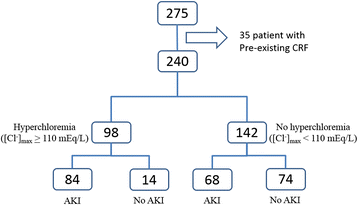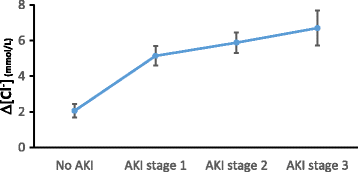Hyperchloremia and moderate increase in serum chloride are associated with acute kidney injury in severe sepsis and septic shock patients
- PMID: 27716310
- PMCID: PMC5053142
- DOI: 10.1186/s13054-016-1499-7
Hyperchloremia and moderate increase in serum chloride are associated with acute kidney injury in severe sepsis and septic shock patients
Abstract
Background: Acute kidney injury and hyperchloremia are commonly present in critically ill septic patients. Our study goal was to evaluate the association of hyperchloremia and acute kidney injury in severe sepsis and septic shock patients.
Methods: In this retrospective cohort study in a provincial tertiary care hospital, adult patients with severe sepsis or septic shock and serum chloride measurements were included. Serum chloride was measured on a daily basis for 48 hours. Primary outcome was development of acute kidney injury (AKI) and association of AKI and serum chloride parameters was analyzed.
Results: A total of 240 patients were included in the study, 98 patients (40.8 %) had hyperchloremia. The incidence of acute kidney injury (AKI) was significantly higher in the hyperchloremia group (85.7 % vs 47.9 %; p < 0.001). Maximal chloride concentration in the first 48 hours ([Cl-]max) was significantly associated with AKI. In multivariate analysis, [Cl-]max was independently associated with AKI [adjusted odds ratio (OR) for AKI = 1.28 (1.02-1.62); p = 0.037]. The increase in serum chloride (Δ[Cl-] = [Cl-]max - initial chloride concentration) demonstrated a dose-dependent relationship with severity of AKI. The mean Δ[Cl-] in patients without AKI was 2.1 mmol/L while in the patients with AKI stage 1, 2 and 3 the mean Δ[Cl-] was 5.1, 5.9 and 6.7 mmol/L, respectively. A moderate increase in serum chloride (Δ[Cl-] ≥ 5 mmol/L) was associated with AKI [OR = 5.70 (3.00-10.82); p < 0.001], even in patients without hyperchloremia [OR = 8.25 (3.44-19.78); p < 0.001].
Conclusions: Hyperchloremia is common in severe sepsis and septic shock and independently associated with AKI. A moderate increase in serum chloride (Δ[Cl-] ≥5 mmol/L) is associated with AKI even in patients without hyperchloremia.
Keywords: Acute kidney injury; Chloride; Hyperchloremia; Sepsis; Septic shock.
Figures


References
MeSH terms
Substances
LinkOut - more resources
Full Text Sources
Other Literature Sources
Medical

